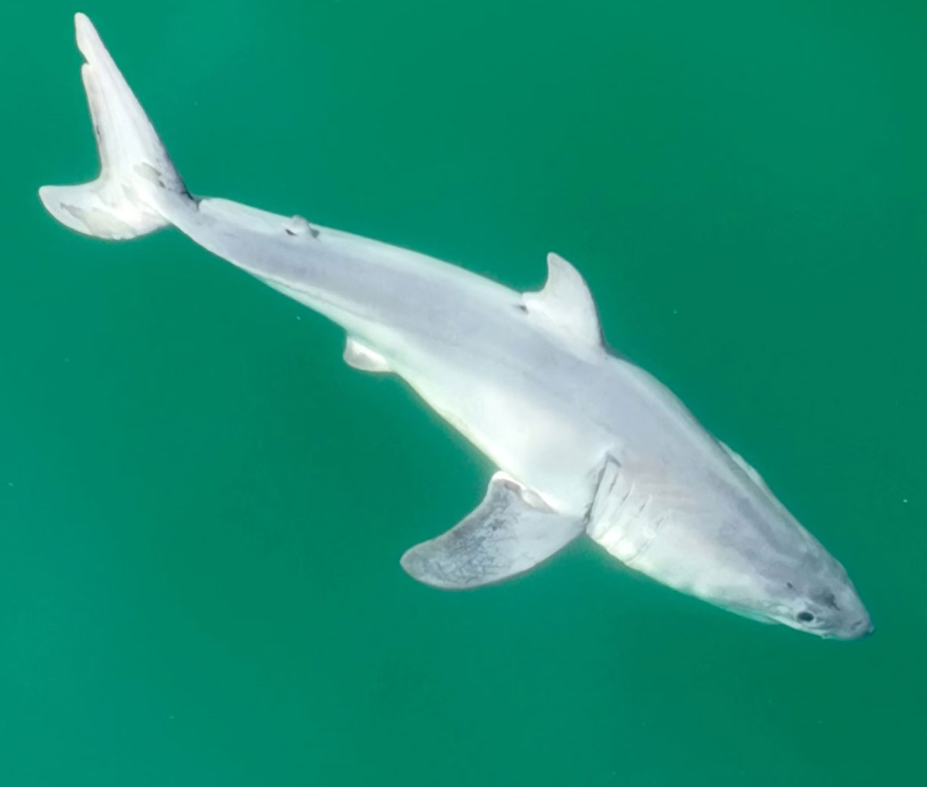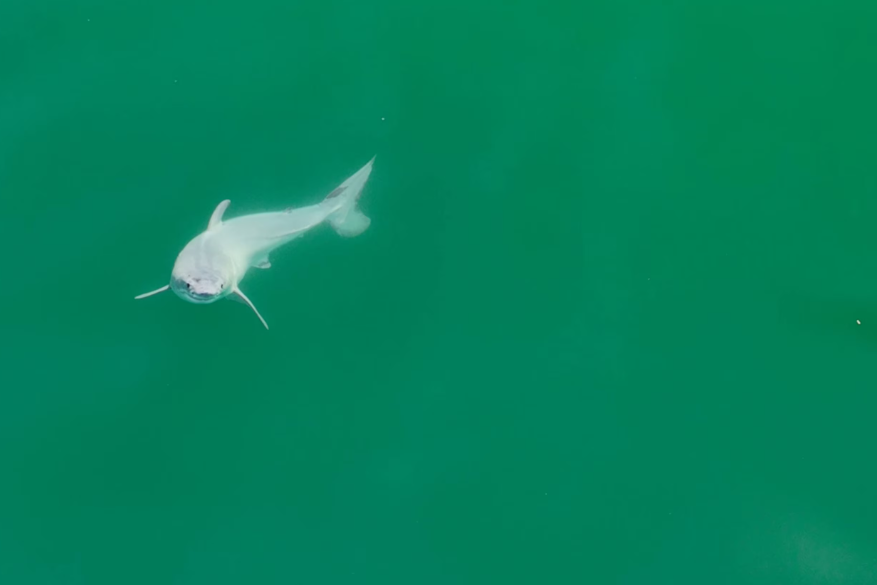
For as much time and money as people have spent studying and filming great white sharks, no one has ever witnessed one being born. But new footage out of California might be the next best thing.
On July 9, 2023, filmmaker Carlos Gauna and organismal biologist Phillip Sternes were following sharks with a drone off the coast of Santa Barbara. They’d already captured footage of a few larger great whites, but then something completely unexpected drifted up out of the murk.
“Toward the end of the day this peculiar-looking white shark appeared, and we were both super excited,” says Sternes, a Ph.D. student at the University of California, Riverside.
At just under five feet long with chubby, rounded fins, the duo knew they were looking at a very young great white. (For comparison, adult great whites can stretch up to 21 feet long.) But as the drone zoomed in, it caught something never seen before—a milky white film that appeared to flake off the young shark’s tail as it swam.
While no one can say for sure what the white material is, Sternes suggests it may be a sort of uterine “milk” used to nourish newborn sharks in the womb. Another possibility is that the shark has a skin condition that has never been described before.
“Both scenarios are highly significant,” says Sternes, who together with Gauna co-authored a study announcing the findings today in the journal Environmental Biology of Fishes.
“This is extremely rare. White shark birthing locations have remained extremely elusive for the scientific community,” Sternes tells National Geographic in an email. “We think we have a piece to the puzzle now. If this is a birthing location, conservation aspects must be considered.”
‘A really unique observation’
To understand just how rare a sighting of a newborn great shark is, you need to first understand that we know surprisingly little about how the world’s largest predatory shark reproduces.
“I think it’s incredible,” says Greg Skomal, a shark biologist with the Massachusetts Division of Marine Fisheries who was familiar with the footage but not involved with the new study. “People don’t realize that some of the most basic questions about white shark reproduction are unanswered.”
Skomal cautioned against making any major conclusions based on the footage, however.
“It’s like any observation. You only have so much information, right? You have the imagery. You got the date, the time, the location. And the rest is speculation,” says Skomal, who is also author of Chasing Shadows: My Life Tracking the Great White Shark.
That said, Skomal did acknowledge that the facts presented would seem to point toward the shark being a newborn.

PHOTOGRAPH BY CARLOS GAUNA (LEFT) AND PHOTOGRAPH BY CARLOS GAUNA (RIGHT)
For instance, the area where it was spotted has been thought to be a great white nursery, as first-year sharks have been documented there before. And Skomal says the shark’s coloration, shape, size, as well as the appearance of the milky white fluid all suggest it’s extremely young.
“That’s led researchers to think it’s a newborn white shark, and it probably is,” says Skomal. “The question is, when was it born? Is it hours, or days [old]? We don’t know that.”
What this means for research
National Geographic Explorer Gibbs Kuguru, a scientist who studies the DNA of sharks, says that the sighting is “a game-changer”—particularly if the white fluid is what researchers suspect it is.
“The fact that we have a shark in the process of shedding its “amniotic fluid” is compelling evidence that we’re looking at a newborn, which is critical because it strongly suggests the shark hasn’t strayed far from its birth site,” he says. “Also, considering the decades of research about finding the elusive mating and birthing locations of Great Whites, stumbling upon a potential pupping ground like this is nothing short of radical.”
Because ocean animals spend the majority of their lives below the water’s surface, sometimes discoveries must wait until scientists happen to be in the right place at the right time. That was certainly the case when scientists witnessed a humpback giving birth for the first time in March 2021.
“We very rarely ever get to see a live newborn white shark, which could have been born within hours,” says Skomal. “And if that’s the case, this is a really unique observation.”
Great white sharks are listed as vulnerable to extinction by the International Union for Conservation of Nature, with the overall population thought to be decreasing. Learning more about where they start their lives would be critical information for scientists seeking to safeguard the future of the species.
As for Sternes, he says, “I look forward to receiving feedback from the scientific community.”
